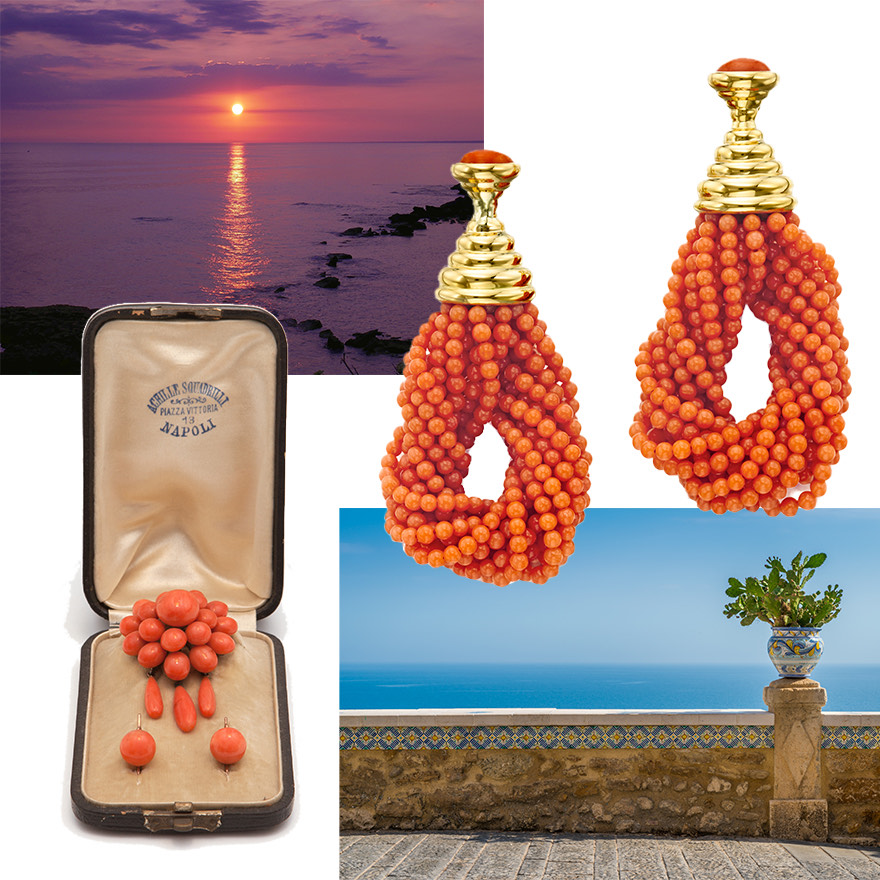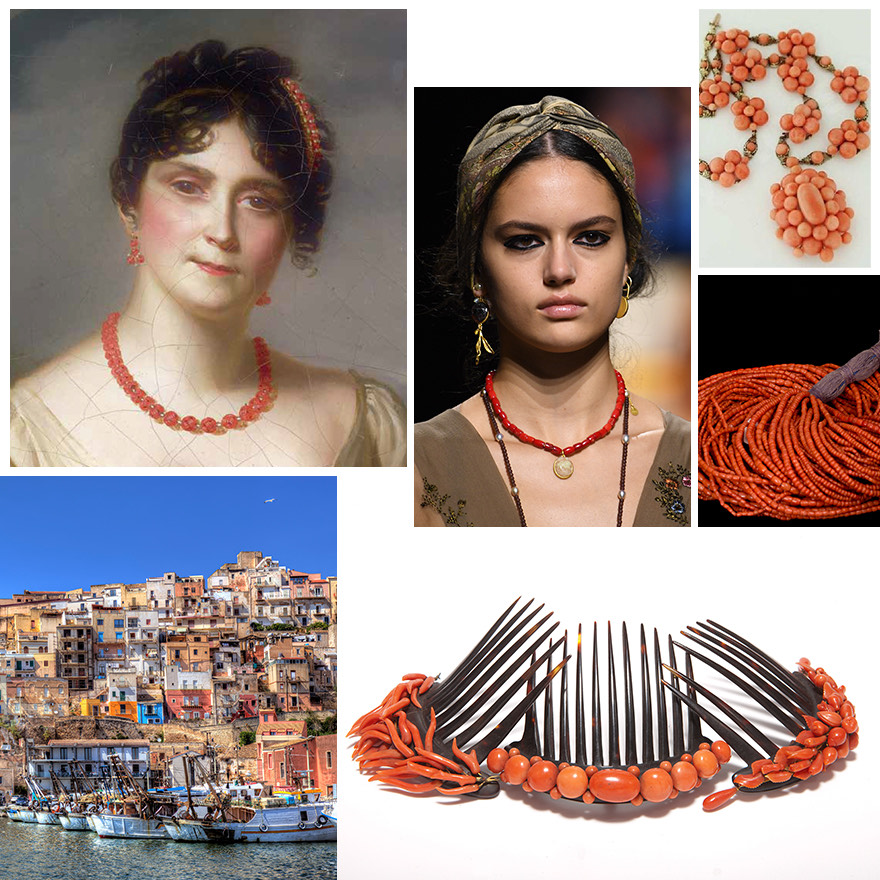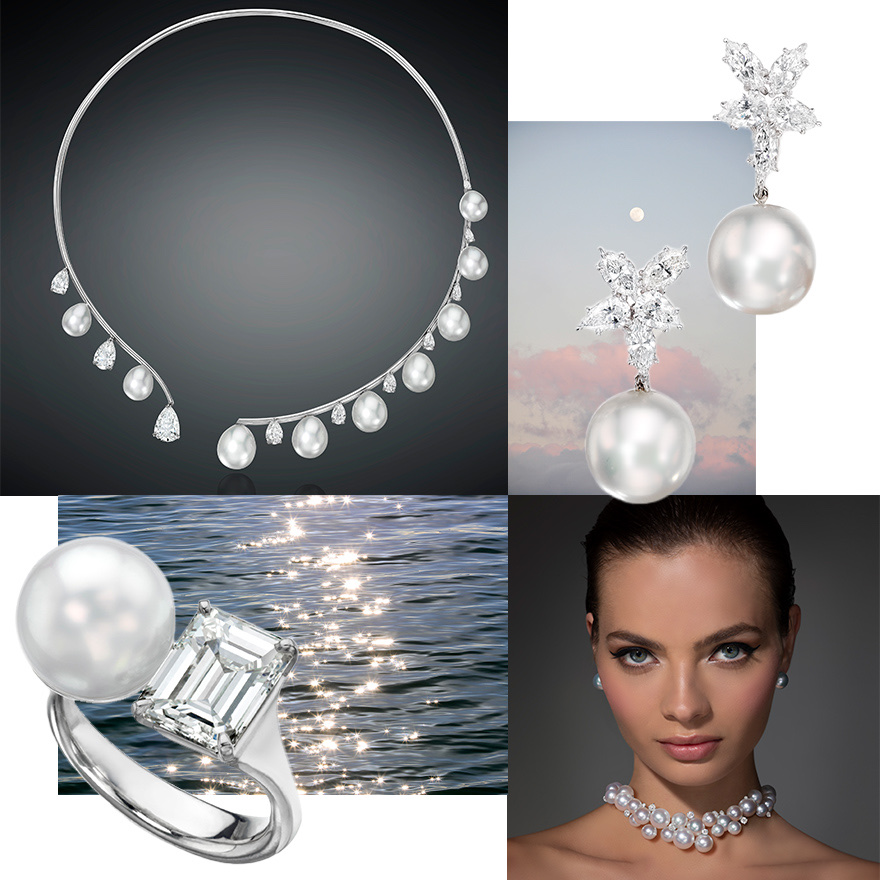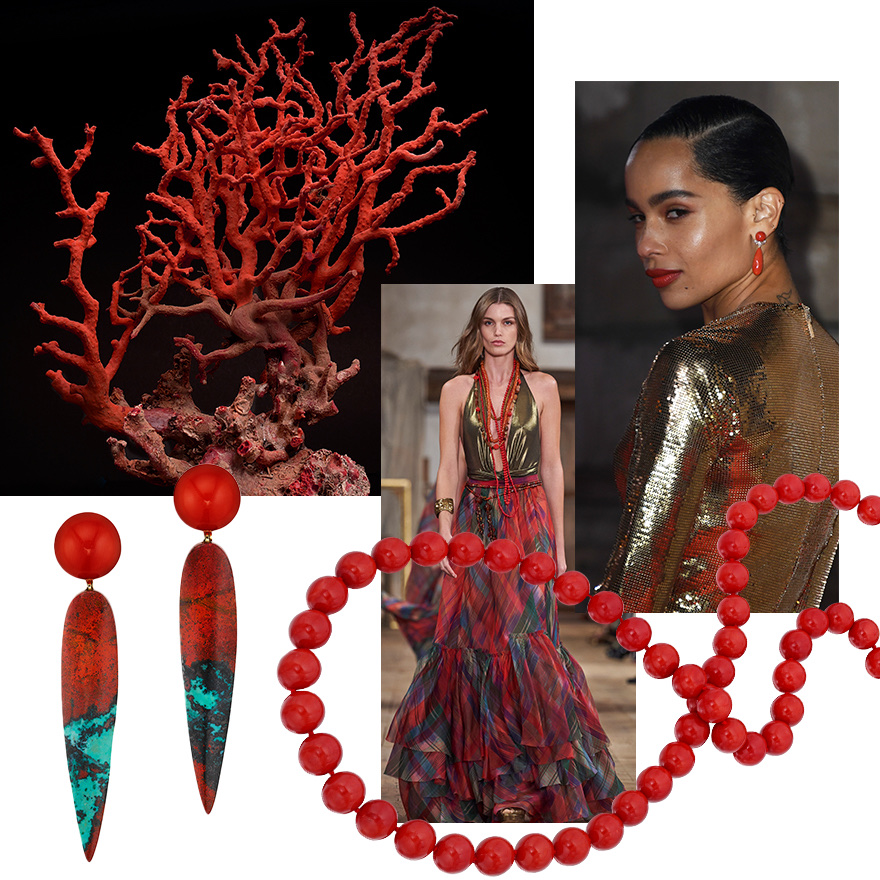
Sciacca Coral – Naturally Sustainable Treasure from the Depths of the Mediterranean 
Sciacca Coral has a long and fascinating history that few people know, its legacy full of mystery and awe. From light peachy pink to shades of orange and red, this coral emits an aura of earthy, casual elegance. The natural wonder of its accumulation and discovery in the depths of the Mediterranean Sea are as remarkable as its beauty. The siren song of Sciacca Coral is warm and sultry, a true tale of treasure that Nature herself preserved for mankind to cherish forever. It is a naturally responsible marvel, worthy of our utmost respect and appreciation.
Assael Sciacca Coral comes from our distinguished partner Enzo Liverino, fourth generation Italian coral expert and now President of Liverino 1894, who helps us learn and discover the magical allure of this very special type of precious coral.
A History of Mystery

Sciacca Coral is named after a coastal town in southern Sicily, where deposits of this coral were discovered in the Mediterranean Sea. In the spring of 1875, a local fisherman named Alberto Maniscalco (aka Bertu Ammareddu) discovered significant quantities of this coral in what is known as the Strait of Sicily, off the coast of the cape of San Marco, near the town of Sciacca. Soon after, hundreds of fishermen began to work the area. According to Liverino, “it was a coral rush, much like the famous gold rush in America.” Over a period lasting a little more than a decade, between the island of Sicily and the northern coast of Africa, over 14,000 tonnes (metric tons)of this special type of precious Corallium rubrum, the same species that produces the treasured Sardinian Coral, were discovered and collected, especially by the fishermen of Torre del Greco. These corals had been deposited on the sandy seabed in sedimentary layers for centuries, with an amazing thickness of 30 meters (roughly 98 feet). Scientists studied this incredible discovery and confirmed that these were not living specimens of coral. Liverino explains that carbon-14 testing showed these astonishing corals to be dated between a few hundred years of age to over 10,000 years old. All of Southern Italy was abuzz in the late 19th century, wondering in awe at this mysterious and miraculous coral.
Geologists were then brought in to study the deposits, which came to be known in the trade as “Sciacca Coral,” to discern the true story of its history. The scientists believe that natural geological events, such as earthquakes, volcanic eruptions, and strong tides, caused the corals to break off and fall to the seabed where they remained, slowly but surely piling up in layers over the centuries.
The other mystery of this coral was origin. How did so much of it end up in this particular area? Liverino explains, “The Mediterranean Sea is known for having very strong underwater currents. These currents channel into the narrow sea between Sicily and Tunisia. It is believed that broken tips of coral branches from Sardinia, Morocco, Algeria, and Tunisia were all carried into the Strait of Sicily over hundreds of years. They accumulated into a drop off in the sea floor which became a giant settling tank for the broken pieces of coral, hence the incredible 30-meter height of the famous Sciacca Coral deposits.”
Liverino marvels, “Each layer contained a fantastic geological history of its creation.” For example, in July of 1831 an earthquake caused an underwater volcano about 26 miles from the beach in Sciacca to open up, spewing lava and debris and actually forming an island of volcanic rock. The island, named Isola de Ferdinandea, was the subject of great debate and interest between competing European powers such as the British Empire, France, Sardinia, and Sicily. The island literally sank just a few months later, disappearing and preempting any geopolitical troubles. But the evidence of the natural volcanic activity can be detected in the darker or burned colors of some of the Sciacca coral branches. Miraculously, they were burned but not destroyed by the hot debris and lava. The magical and intriguing “burned” Sciacca corals are known as “affumato” (smoked in English) and have very distinct hues.
A Legacy of Beauty

Precious corals have been fished from in the Mediterranean since pre-historic times. Ancient civilizations prized the intense and enduring crimson hues and often wore corals for adornment, as well as for security. Egyptians loved corals and coral jewelry as protection, believing its deeply red color contained drops of divine blood which would ward off evil spirits in the afterlife. Roman nobility hung coral branches around the necks of their children to safeguard them from danger. According to the American Gem Trade Association, “coral inlays and ornaments have been found in Celtic tombs dating from the Iron Age (1200 – 600 B.C.).”
There have been many examples throughout history of coral’s reverent use for religious rituals. In the Eastern cultures, coral has been a part of Hindu, Buddhist, and Islamic traditions, as well as Jewish traditions. Since the 16th century, coral has been used in Christian rosaries throughout Europe and the Orient. The “paternoster” coral rosaries were worn as necklaces or hung on belts. In the 17th and 18th centuries, coral became the fundamental gem to express the passion of Christ in all Italian Baroque masterpieces, sacred or secular. Even today, the unique beauty of precious coral continues to be used in high jewelry collections and works of art of by leading Fifth Avenue and Place Vendome jewelers.
Liverino suggests that organized artisanal harvesting in the Mediterranean really began during the Roman Empire. Techniques for finding and fishing these beautiful treasures from the sea were refined over time and became much more sophisticated in the Middle Ages, around the 9th century. At that time, Arabian fishermen, known as the supreme “pirates” or masters of the seas just north of Africa, were rich sultans bedecked in colorful gemstones. They are likely the ones to have first discovered these rich coral deposits in the Straits of Sicily because the name is derived from the Arabic word “Shaqqa,” reportedly even before the official date of discovery.
Always on the search for natural marvels, the Arabs developed an ingenuous wooden device to selectively retrieve coral from the challenging and rocky substrate of the seabed. The device, in the shape of Saint Andrew’s cross, had nets attached to each of the four corners. Highly skilled skippers would maneuver the boats, gliding the cross below the sea gorges to capture the coral. The device became known as the “ingegno” because it was an ingenious tool that helped the fishermen to collect the corals. One can try to imagine the scene, says Liverino, “an entire crew stunned by the natural beauty of their harvested treasure, its powerful red hues glistening in the rays of the morning Mediterranean sun.”
That long-lasting color is one of the beloved hallmarks of precious coral, including Sciacca Coral. “I love the warm pastel colors,” says Liverino “and the feeling of antiquity that they suggest.” He explains that the layers of the Sciacca Coral vary in many ways, by color and by conditions related to its age or the depth in the seabed. The surface layer tended to be the darkest in hue. As the coral descended due to the earthquakes, volcanic activity, and strong currents mentioned above, “…the coral continued to decompose, over time, gently losing some of its color. So, the deeper or older layers of Sciacca Coral tended to be more orange or even pink.” Each hue is distinctly beautiful of its own accord, offering a variety for coral lovers to collect and wear.
Naturally Responsible and Eco-Friendly

Enzo Liverino is not only the President and Owner of Liverino 1894. He is also the proprietor of the Museo del Corallo, Collezione Privata Liverino. In the museum, he has many antique specimens of coral that beautifully portray the history of precious corals. He is a staunch advocate for sustainability, as well, because without healthy oceans, there is no more coral. He assures us that “there is no doubt that most deep-sea corals are sustainable and rightly protected.” Precious corals are very tightly controlled by many international governing bodies to ensure that the coral species are never over-harvested or diminished. To learn more about precious corals, visit our guest blog post by Gem Education Consultant Rui Galopim de Carvalho FGA DGA entitled “Understanding Precious Corals.”
Sciacca Coral is a very special material because it was never harvested while it was alive. It is important to note that all of the Sciacca Coral from that remarkable 30-meter deposit has been collected. The deposit is depleted, having been gathered in the late 19th century. In a sense, it is vintage coral or some call it “fossil coral,” consisting of branches that broke off due to natural events (as referenced above) and collected in deposits along the seabed. Mother Nature swept this unique treasure along in the current to be gathered in sedimentary layers for mankind to later discover, retrieve, and cherish as fine jewelry and objets d’art.
Sciacca Coral is antique, a rare material that has no impact on today’s environment, nor on the modern biodiversity of the Mediterranean. It represents the perfect opportunity for us enjoy and wear one of the most exquisite finite gifts of the sea, in a highly responsible way, with utmost respect for the ocean and its ecosystem. As they have for thousands of years, the ocean tides will continue to naturally break off coral branches. Hopefully, this will someday provide us with the possibility of future discoveries of this ultimate sustainable adornment!
Feature image at top – clockwise from upper right – antique map of Sicily showing location of coastal town of Sciacca and where the coral deposits were found, Assael Multistrand Sciacca Coral Bracelet, layouts of Sciacca Coral from Liverino Museum
If you liked this, you might also like:
Understanding Precious Coral Jewelry
Defining Exceptional – The Beauty and Luxury of Angel Skin Coral
Sustainable Coral – Exquisite, Rare, and Exceedingly Precious
Posted on Jul 26, 2022 in History, Pearl Education by Duvall O'Steen
Articles you may also enjoy
Join our Mailing List
Join us for magnificent pearl trends and exclusive treasures. Discover a world that is truly ... beyond rare.

Feeling inspired?
Consider this your invitation to the House of Assael. Find your closest luxury jeweler using our map search and start your journey to timeless elegance.




